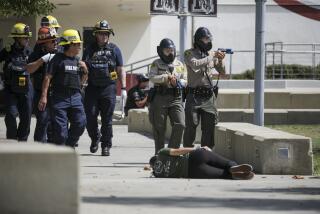School Bus Seat Belt Issue Revived
- Share via
It sounds like a simple question: Should seat belts be installed on school buses, as a pending California Assembly bill would require? They undoubtedly make automobiles safer, so why not buses?
Orange County school officials and bus manufacturers say it’s not quite that easy. A host of legal, financial and logistical questions surround the issue.
For example: Should schools take money away from educational programs to install seat belts when buses are among the safest vehicles on the road?
How does one bus driver force 50 or 60 rambunctious kids to keep their seat belts on? And if the driver can’t, who would be liable if children are injured because they aren’t wearing them?
The federal government is examining some of those issues in a study expected to come out next year.
In California and a few other states, legislators are already moving forward. Assemblyman Martin Gallegos (D-Baldwin Park) is pushing a bill to require lap-and-shoulder belts on all new California school buses starting in 2002.
Many local school officials express ambivalence over the proposal.
“Until it’s all been [addressed] in one package, no, I wouldn’t want seat belts on the buses I supervise right now, because they’re too old and we don’t have the money to replace them,” said Dorothy Phillips, transportation supervisor for the Huntington Beach City School District.
“It doesn’t mean I care for the kids any less. My own children rode these buses, and if my grandchildren lived here, they’d ride them.”
All sides in the debate agree that school buses, even without seat belts, are a safer means of transportation than automobiles.
While 5,111 children died in car accidents nationally in 1997, according to the U.S. Department of Transportation, only six in school buses were killed--none in California.
In fact, more children in school bus-related accidents are typically killed outside the bus--either struck by cars when drivers don’t see them or by the bus when they try to pick up a backpack that has fallen near the wheels.
Currently, school buses rely on a crash-protection method known as “compartmentalization.” It’s similar to an egg carton: The backs of seats are padded, and children are kept close together, giving them less room to fly around in an accident. The seats are also made of a material that collapses relatively easily in a crash, and they have higher seat backs that keep children from flying forward or into the ceiling.
But safety and school officials debate whether that is enough.
“I don’t think any injuries are acceptable when there’s a preventable measure” that may protect some children, said Dr. Phyllis Agran, director of the Pediatric Injury Prevention Research Group at UC Irvine.
Karen Finkel, executive director of the National School Transportation Assn., a bus manufacturers’ group, said it remains unproved whether seat belts would really provide more protection for kids. Lap belts alone have been found to occasionally cause injuries in a crash because the unrestrained upper half of children’s bodies can whip forward into the seat ahead, she said.
For school districts, cost and liability are major concerns.
Estimates vary, but Gallegos’ office says seat belts add at most $2,200 to the cost of a new bus.
But Nancy LaCasse, legislative director of the California Assn. of School Business Officials, which opposes the bill, notes that seat belts might reduce capacity on buses from three children per seat to two, forcing districts to buy many more buses than anticipated.
And equipping only the new buses with seat belts, but leaving the current fleet without them, could expose school districts to lawsuits, she added.
More to Read
Sign up for Essential California
The most important California stories and recommendations in your inbox every morning.
You may occasionally receive promotional content from the Los Angeles Times.










